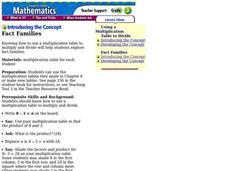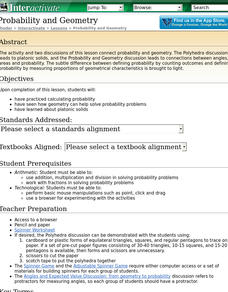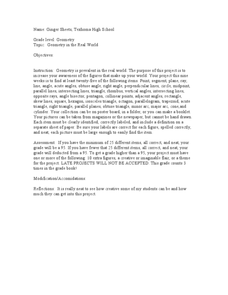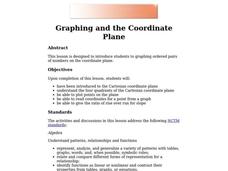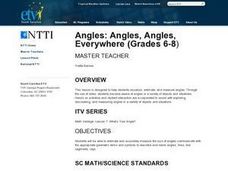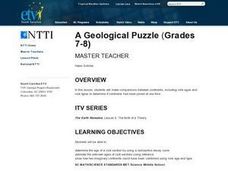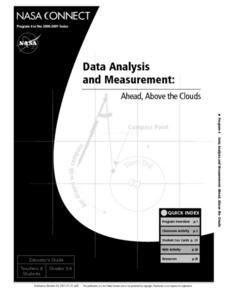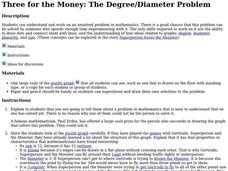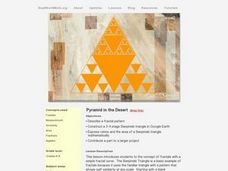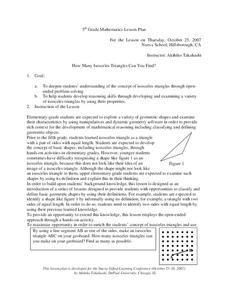Curated OER
Exploring Geometry in the Real World
Students find real-world examples of a variety of geometric shapes. They conduct research, record observations, and write descriptions. They create a classroom cityscape and highlight the information they gathered. They present an oral...
Curated OER
Polymer
Learners investigate polymers by completing 3 experiments. In this polymer lesson plan, students mix plastic with acetone, they create polyurethane foam, they make slime and build a polymer model once their polyurethane foam is set. ...
Curated OER
Fact Families
Students explore fact families. In this multiplication lesson, students use a multiplication table to find the answers to several multiplication equations. Students form fact families from each completed equation.
Curated OER
Exploring the Circumcenter of a Triangle
Students construct the circumcenter of a triangle. For this constructing the circumcenter of a triangle lesson, students construct a triangle using Cabri Jr. Students draw perpendicular bisectors of the sides of the triangle. Students...
Curated OER
Exploring the Orthocenter of a Triangle
Young mathematicians explore the concept of triangles as they construct altitudes of triangles to find the orthocenter. Learners construct their triangles using Cabri Jr. on their graphing calculators and find that the altitudes of a...
Curated OER
Probability and Geometry
Students practice calculating probability, see how geometry can help solve probability problems and explore platonic solids.
Curated OER
Geometry in the Real World
Eighth graders complete a unit of lessons on basic geometry concepts. They participate in a variety of activities, culminating in a project that involves publishing a booklet or a poster that presents the major geometry concepts from the...
Curated OER
Which Brand of Air Freshener is Most Cost Effective?
Young scholars use scientific method to determine cost-effectiveness of air freshener, and create PowerPoint presentations to share their results.
Curated OER
Triangle Classificaition with Geometer's Sketchpad.
Students use Geometer's Sketchpad to draw triangles and explore the classificaiton of each using the mearsures of interior angles and the lengths of the sides.
Curated OER
Graphing and the Coordinate Plane
Students examine the four quadrants of Cartesian coordinate plane. They play maze games and coordinate games to discover how to read and plot points on the plane. Students plot points on the coordinate plane and examine the ratio of...
Curated OER
Angles: Angles, Angles, Everywhere
Students practice estiminating and measuring angles. After watching a short video, they identify angles in objects in the classroom and their homes. In groups, they participate in activities in which they are given a scenerio and are...
Curated OER
A Geological Puzzle
Students compare and contrast the various types of rocks on each continent. In groups, the calculate the rock ages and types to determine if the continents, in their opinion, were joined at one time. They develop two imaginary...
Curated OER
Data Analysis and Measurement: Ahead, Above the Clouds
Students explore and discuss hurricanes, and examine how meteorologists, weather officers, and NASA researchers use measurement and data analysis to predict severe weather. They plot points on coordinate map, classify hurricanes...
Curated OER
How Does Your Garden Grow?
Students construct and maintain a school garden. In this gardening lesson, students plan the construction of the garden by writing letters to local businesses asking for supplies and materials; students build the garden using their math...
Alabama Learning Exchange
The Mean, Median, and Mode Chain Gang
Learners analyze a set of data. They work in cooperative groups and use chain links to identify the mean, median, and mode of the chain.
Curated OER
Three for the Money: The Degree/Diameter Problem
Learners explore the degree, diameter, planarity, and size of graphs. In this degree, diameter, planarity, and size of graphs instructional activity, students try to construct a graph with more than 12 vertices that satisfy all...
Curated OER
Water Wonders
Students explore hydrology concepts. In this environment and biology lesson, students identify and describe macroinvertebrates using a variety of pictures and resources. Students observe and write about a classroom aquarium in which...
Curated OER
Triangles in My Life
Tenth graders investigate where in the real world triangles are used. In this geometry lesson plan, 10th graders write an essay describing where in their lives triangles are used. They can use food, buildings, clothing or anything...
Curated OER
What are the Kinds of Triangles?
Fifth graders classify triangles. In this triangle lesson, 5th graders learn about the characteristics that make up a triangle. They are instructed through video, PowerPoint slides, and teacher-led demonstrations.
Curated OER
Pyramid in The Desert
Students investigate the Sierpinski triangle and calculate the ratio and area of the triangle. In this fractals lesson, students calculate parts of a Sierpincki triangle. They use Google Earth to help them construct the different parts...
Curated OER
Follow Those Tracks
Students observe a picture containing patterns of animal tracks, infer what might have happened based upon the pattern of tracks, and write a story describing what might have happened.
Curated OER
How many isosceles Triangles Can You Find?
Fifth graders solve problems while examining a variety of isosceles triangles. For this isosceles triangle lesson, 5th graders examine shapes to find their characteristics. Students pay particular attention to the...
Curated OER
How many edges do I need to cut in order to open a cube?
Students problem solve to open a cube to create different shapes. For this problem solving lesson plan, students are given a cube and the shapes to open it up to, and they have to cut the cube open to make certain shapes. This gives them...
Curated OER
The Second Fundamental Theorem of Calculus
Students investigate the fundamental theorem of calculus. In this calculus lesson, students derive the fundamental theorem of calculus. They differentiate between the first and second theorem.


